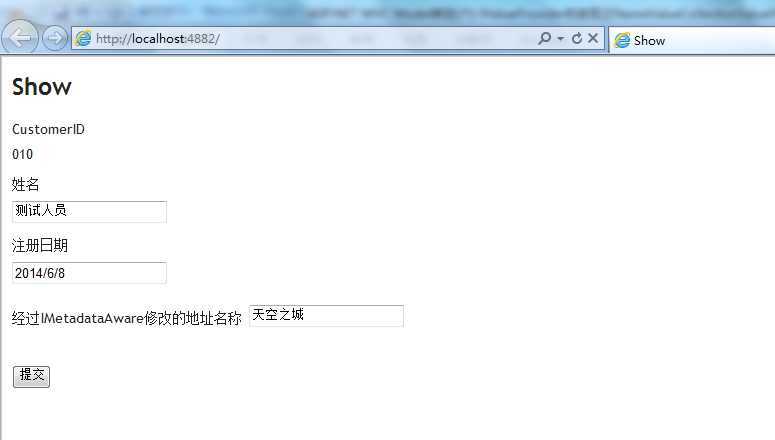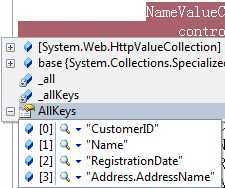标签:asp.net mvc modelbinder .net c# mvc
前面的篇幅对于IValueProvider的使用做个基础的示例讲解,但是没并没有对 IValueProvider类型的实现做详细的介绍,然而MVC框架中给我们提供了几种默认的实现类型,在本篇中将会对NameValueCollectionValueProvider类型做一个示例讲解,了解一下MVC框架给我们提供的值提供程序是怎么处理Model值的。
前面的一篇中我们对IValueProvider的使用作了示例演示,那是一个从控制器方法到视图的一个绑定的过程,大家有没有想过在视图里的数据是怎么在绑定回控制器部分的。视图中的数据类型的不同对应的使用绑定的类型也不同,本篇就为大家示例一个自定义类型的绑定。
代码1-1
public class Customer { [HiddenInput(DisplayValue=true)] public string CustomerID { get; set; } [Display(Name="姓名")] public string Name { get; set; } [DataType(DataType.Date)] [Display(Name="注册日期")] public DateTime RegistrationDate{ get; set; } [UIHint("Address")] public Address Address { get; set; } } public class Address { [Display(Name="地址名称")] [MyCustomMetadataAware] public string AddressName { get; set; } }
对的代码1-1中的类型已经出现过很多次了,但是出于对没看过前面篇幅的朋友负责的态度也要加上阿,这是下面示例要用到的示例ViewModel。
首先我们需要数据展示:
代码1-2:
public class ValueProviderCaseController : Controller { public ViewResult Show(Customer customer) { return View(customer); } }
代码1-2中定义了个Show()方法,参数类型为代码1-1所示类型。
看下Show()方法对应的视图,当然了这样创建的是强类型视图,代码1-3.
代码1-3
@model ConsoleApplication2.Customer @{ ViewBag.Title = "Show"; } <h2> Show</h2> @using (Html.BeginForm("Update", "ValueProviderCase")) { <p>@Html.EditorForModel()</p> <p>@Html.EditorFor(m => Model.Address)</p> <br /> <input type="submit" value="提交" /> }
在代码1-3中,我们也看到了,使用了BeginForm()视图辅助器,并且令表单指向ValueProviderCase 控制器的Update()方法,这个后面会说到,暂且带过。现在这个时候我们还运行不了项目,我们需要为代码1-2中的Show()配置一个Model绑定器,代码1-4.
代码1-4
public class MyCustomModelBinder : IModelBinder { public object BindModel(ControllerContext controllerContext, ModelBindingContext bindingContext) { if (controllerContext.HttpContext.Request.RequestType == "GET") { return new Customer() { CustomerID = "010", Name = "测试人员", RegistrationDate = DateTime.Now, Address = new Address() { AddressName = "天空之城" } }; } return null; } }
从代码1-4中,我们可以看到对Model绑定器做了控制,使它在请求类型为Get的时候返回代码1-1所示类型的ViewModel实例。因为后面的示例我们也还会用到这个Model绑定器,所以加了控制。对于Model绑定器的注册这里就不说了,运行结果如图1.
图1

如果这个时候我们单击提交按钮会把数据会变成什么样子呢?数据到了当前系统上下文中。
NameValueCollection
为什么要讲到NameValueCollection类型呢,因为NameValueCollectionValueProvider类型中的操作就是针对的NameValueCollection类型的,这里我们来看图1中点击提交后的的数据展示如图2
图2

说好了数据呢?大家别急,图2中的是NameValueCollection类型的AllKeys属性中的值,而NameValueCollection类型的实例是通过controllerContext.HttpContext.Request.Form这样获取而来,也就是上面说到的点击“提交”后所形成的数据类型。而我们的NameValueCollectionValueProvider类型则是对NameValueCollection类型的处理,具体的内部处理细节就不在这详细描述了。
下面我们需要做提交后的操作,就是显示到更新界面,那我们得按照上面代码1-3中的定义的那样,需要个Update()方法,示例代码1-5.
代码1-5
public class ValueProviderCaseController : Controller { public ViewResult Show(Customer customer) { return View(customer); } [HttpPost] public ActionResult Update(Customer customer) { return View(customer); } }
这个时候我们是看不到绑定器内部的实现的,所以我们来模拟一下,修改上面代码1-4中的内容,如示例代码1-6.
代码1-6
public class MyCustomModelBinder : IModelBinder { public object BindModel(ControllerContext controllerContext, ModelBindingContext bindingContext) { if (controllerContext.HttpContext.Request.RequestType == "GET") { return new Customer() { CustomerID = "010", Name = "测试人员", RegistrationDate = DateTime.Now, Address = new Address() { AddressName = "天空之城" } }; } else if (controllerContext.HttpContext.Request.RequestType == "POST") { Customer customer = new Customer(); customer.Address = new Address(); NameValueCollection nameValueCollection = controllerContext.HttpContext.Request.Form; NameValueCollectionValueProvider nameValueCollectionValueProvider = new NameValueCollectionValueProvider( nameValueCollection, System.Globalization.CultureInfo.InstalledUICulture); customer.CustomerID = GetValue(nameValueCollectionValueProvider, "CustomerID"); customer.Name = GetValue(nameValueCollectionValueProvider, "Name"); customer.RegistrationDate = DateTime.Parse(GetValue(nameValueCollectionValueProvider, "RegistrationDate")); customer.Address.AddressName = GetValue(nameValueCollectionValueProvider, "Address.AddressName"); return customer; } return null; } private string GetValue(IValueProvider valueProvider, string preFix) { return valueProvider.ContainsPrefix(preFix) ? valueProvider.GetValue(preFix).AttemptedValue : null; } }
这里忘了说了,可以把NameValueCollection类型想象成一个键值队类型的集合,并且NameValueCollection类型的实例已经包含着所有数据了,可以使用它内部的GetValue方法(并非代码1-6中的GetValue方法)来获取所对应的值,在NameValueCollectionValueProvider类型内部也是使用的这个方法来获取的值。
在代码1-6中我们对Model绑定器修改了太多了,首先是控制器了在请求类型为POST的时候(也就是为了在请求Update()方法时所用)使用这个Model绑定器,随之我们实例化了一个代码1-1中所示的ViewModel实例,后面会对它进行赋值,随后我们通过上下文获取到表单中的数据(NameValueCollection类型的实例)作为NameValueCollectionValueProvider类型构造函数的参数,我们还在Model绑定器中定义了个私有的GetValue()方法,这个的用途就是根据执行的前缀(NameValueCollection类型中的键值,也就是视图元素中的Name属性)从NameValueCollectionValueProvider类型的实例中获取对应的数据。
现在看一下Update()方法所对应的视图代码,示例代码1-7
@model ConsoleApplication2.Customer @{ ViewBag.Title = "Update"; } <h2> Update</h2> <p>@Html.EditorForModel()</p> <p>@Html.EditorFor(m => Model.Address)</p>
这个时候我们可以运行项目,首先看到Show页面后,修改其中的值,然后提交过后会看到修改的值已经更新到了Update的界面中。
作者:金源
出处:http://blog.csdn.net/jinyuan0829
本文版权归作者和CSDN共有,欢迎转载,但未经作者同意必须保留此段声明,且在文章页面
ASP.NET MVC Model绑定(六),布布扣,bubuko.com
标签:asp.net mvc modelbinder .net c# mvc
原文地址:http://blog.csdn.net/jinyuan0829/article/details/36717883